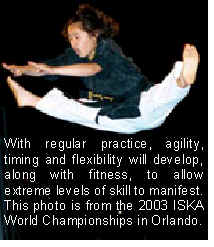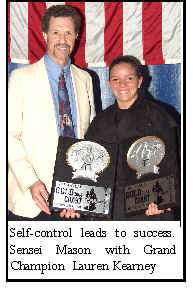
JUNE NEWS
The Purpose of Free Sparring
In the course of karate training, all students are confronted from time to time with strong emotions like fear and anger. Part of the purpose in training is to learn how to deal constructively with these feelings in the relative safety of the Dojo. After overcoming some initial anxiety at the beginning of training, students find that karate lessons are challenging and enjoyable, so that in basic classes they develop a confidence that balances their emotions.
With the onset of Orange Belt, however, this emotional equilibrium is often disturbed. Students discover that they must study strategy in a level two class and learn how to practice free sparring in order to achieve Blue Belt. Panic and fear sometimes overcome reason at this point and they have visions of being bounced off the walls by enthusiastic Brown Belts.
Actually, the strategy class and free sparring often become a favored style of practice for advanced students. In the beginning, it is the emotions, particularly fear and pride, that deter the novice strategist. The main difficulty lies in the confusion that students have, sometimes, between free sparring and fighting. A fight is something which we are all training to avoid. However, should we ever have to fight in self-defense, we want to be effective. Free sparring, on the other hand, is a training process in which we practice distancing and timing while attempting to execute controlled techniques with our partner. Many strikes and strategies are not allowed during sparring because they are too dangerous. Sparring rules observed in the Dojo and are enforced to enhance safety. Another safety feature is the requirement that all students be fully equipped with hand and foot pads, headgear, shins, mouthpiece, groin cup or chest protector.

Actually, free sparring is a lot like fencing. Instead of one weapon, however, you have four, two hands and two feet. The idea is to touch your sparring partner with light contact, by focusing to the skin or the outside of the headgear, rather than through the body or head. Techniques should simulate delivery of a significant strike. Power and speed are present but focused to touch rather than hit. Sparring then is like a game of tag, played with karate techniques for the purpose of practicing distancing and timing. With the confidence gained through practice, students often find strategic sparring practice to be their favorite class.
Several benefits ensue from being the master of your emotions, including improved confidence, high self-esteem and development of a winning attitude. These qualities enhance our life outside as well as inside the karate Dojo. The strategy classes are designed to introduce students to sparring in the relative safety of the controlled Dojo environment. Tournament sparring can be a useful next step to extend these abilities. Many of the skills developed in strategy class are essential for applying karate techniques in self-defense. Sparring is the way to discover the strategist within. Practice of our basics, pairs techniques and Kata give us the tools we need to be able to spar with confidence.
Sensei Robert H. Mason © 2004
Character Traits and Putting Kids to Work
According to an article which appeared recently in the Sun-Sentinel “spoiled, indulged children may grow up to be incompetent adults who lack life and self-care skill, have an overblown sense of entitlement, have trouble learning how to delay gratification, expect to be the constant center of attention, are reluctant to take personal responsibility, have difficulty knowing what is normal or enough, have an unrealistic sense of their strength and weaknesses.” What the article recommends is that our youngsters learn the value of work and responsibility by having jobs to do at home. “Parents who don’t require their kids to do chores may be setting them up for failure,” according to these experts.
Two-thirds of parents say their children are spoiled, according to a 2001 TIME/CNN survey. What they mean by “spoiled” is that these children have an overblown sense of entitlement. “Parents think they overindulged out of kindness, but they ’re training kids to be helpless and irresponsible”, according to Connie Dawson, author of “How much is enough?” When children feel that they can ask for and receive pretty much whatever they want, regardless of what they contribute to the household they are “spoiled”. “It looks good and it feels good at the time, but over the long haul, overindulgence undermines a child’s confidence and competence,” said Connie Dawson.

Naturally children complain when they do not get what they want. As babies we all cried when we were uncomfortable or hungry. As we became older we learned better self-control and communication skills. However, many children are hampered in their development by being “spoiled”. Karate training requires that all students, even the youngest, learn to maintain a growing level of self-control. In the Dragons or Tigers programs the class is structured to keep their interest level high by having a fun time improving on balance, coordination, fitness and flexibility as they practice the karate moves. Once children get into the Junior program we extend the same skills while also developing their attention span and ability to tolerate postponement of gratification, a higher degree of self-control, and extending their ability to cope with both physical and psychological discomfort. This process develops not just physical strength and skill, but also emotional and psychological strength. It also takes time, and requires that parents be patient and trust the process to achieve the goals. Among the lessons learned are those that are outlined in our Black Belt Club application: Modesty, Courtesy, Integrity, Perseverance and Courage. All of these traits are an extension of self-control, and they all contribute to the development of character.
“Is our nation suffering from character fatigue?” is a question asked by Broward School Superintendent Frank Till. In response the School Board has created a character education program which identifies eight traits: responsibility, honesty, citizenship, self-control, kindness, tolerance, respect, and cooperation that are taught as life skills in age-appropriate curriculum material. This is the kind of program that will support our program and, along with parental support, give our students the opportunity for consistent development in and out of the Dojo.
“With ordinary talent and extraordinary perseverance,
all things are attainable.”
Thomas F. Buxton